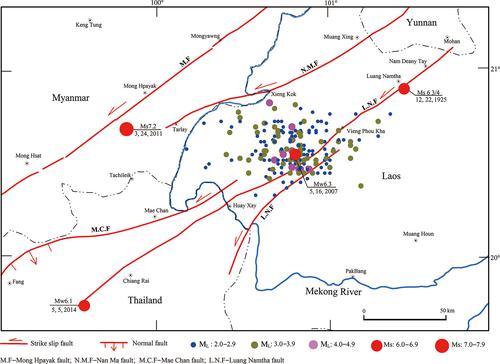当前位置:
X-MOL 学术
›
Acta Geol. Sinica Engl. Ed.
›
论文详情
Our official English website, www.x-mol.net, welcomes your feedback! (Note: you will need to create a separate account there.)
The 2014 Northern Thailand Mw 6.1 Earthquake and its Seismogenic Tectonics
Acta Geologica Sinica-English Edition ( IF 3.3 ) Pub Date : 2021-06-21 , DOI: 10.1111/1755-6724.14775 Zufeng CHANG 1 , Pin‐liang DONG 2 , Renmao YUAN 3 , Jianjun HOU 4 , Zhongtai HE 5 , Jianlin LI 1 , Hao CHANG 1
Acta Geologica Sinica-English Edition ( IF 3.3 ) Pub Date : 2021-06-21 , DOI: 10.1111/1755-6724.14775 Zufeng CHANG 1 , Pin‐liang DONG 2 , Renmao YUAN 3 , Jianjun HOU 4 , Zhongtai HE 5 , Jianlin LI 1 , Hao CHANG 1
Affiliation

|
On May 5, 2014, an earthquake with a magnitude of Mw 6.1 (the largest earthquake in Thailand so far) occurred in Chiang Rai of the Golden Triangle area in northern Thailand. We had an opportunity to conduct field survey immediately after the earthquake. Serious damage to buildings and casualties of lives were observed, and the estimated Maximum Mercalli Intensity (MMI) of the earthquake is VIII (evaluated according to the MMI scale of the Chinese Standard). No long continuous ground ruptures were produced during the earthquake, but in the epicenter (commonly within MMI VIII extent), massive small linear ruptures (usually several tens of meters long) developed and displayed intriguing structural features, offsetting many roads several centimeters left laterally on NE trending cracks or offsetting right laterally on NW trending ones. The focal mechanism solution of earthquake shows that this is a pure strike-slip event, and two nodal planes in NW and NE directions had the same motion senses respectively as those of breakage associated with the earthquake. The long axis of the isoseismals and aftershock distributions are in NE direction, which is consistent with the strike of Luang Namtha fault. The 230-km-long Luang Namtha fault which starts from the border of China and Laos, runs through northern Laos, and terminates at Chiang Rai of Thailand is predominated by left-lateral strike-slip and active in late Quaternary, and two earthquakes over Ms 6.0 occurred along the fault in 1925 and 2007 respectively. This Mw 6.1 earthquake occurred at the southwestern end of the fault. All related features such as evident structural rupturing, elongated orientation of MMI and aftershock distribution, as well as the location of the epicenter, suggest that the Luang Namtha fault may be responsible for the 2014 Northern Thailand earthquake.
更新日期:2021-06-21



























 京公网安备 11010802027423号
京公网安备 11010802027423号